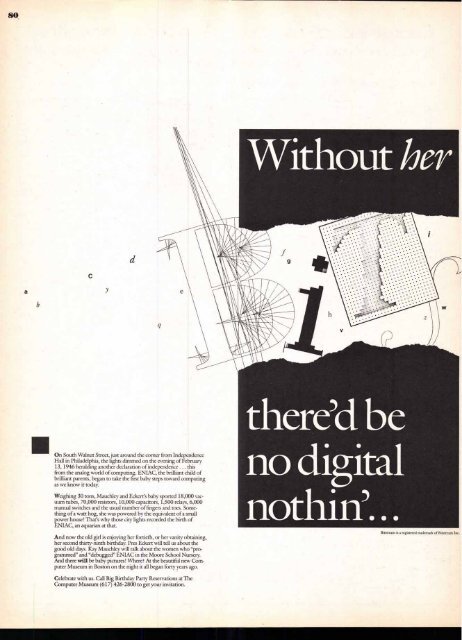Volume 12–4 (Low Res).pdf - U&lc
Volume 12–4 (Low Res).pdf - U&lc
Volume 12–4 (Low Res).pdf - U&lc
Create successful ePaper yourself
Turn your PDF publications into a flip-book with our unique Google optimized e-Paper software.
84:k<br />
a<br />
b<br />
C<br />
On South Walnut Street, just around the corner from Independence<br />
Hall in Philadelphia, the lights dimmed on the evening of February<br />
13, 1946 heralding another declaration of independence . . . this<br />
from the analog world of computing. ENIAC, the brilliant child of<br />
brilliant parents, began to take the first baby steps toward computing<br />
as we know it today.<br />
Weighing 30 tons, Mauchley and Eckert's baby sported 18,000 vacuum<br />
tubes, 70,000 resistors, 10,000 capacitors, 1,500 relays, 6,000<br />
manual switches and the usual number of fingers and toes. Something<br />
of a watt hog, she was powered by the equivalent of a small<br />
power house! That's why those city lights recorded the birth of<br />
ENIAC, an aquarian at that.<br />
And now the old girl is enjoying her fortieth, or her vanity obtaining,<br />
her second thirty-ninth birthday. Pres Eckert will tell us about the<br />
good old days. Kay Mauchley will talk about the women who "programmed"<br />
and "debugged" ENIAC in the Moore School Nursery.<br />
And there will be baby pictures! Where? At the beautiful new Computer<br />
Museum in Boston on the night it all began forty years ago.<br />
Celebrate with us. Call Big Birthday Party <strong>Res</strong>ervations at The<br />
Computer Museum (617) 426-2800 to get your invitation.<br />
d<br />
Without her
















